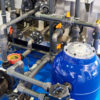Keeping a clean pool can help prevent expensive damages as well as give you the perfect backyard. Regular maintenance is key to keeping your pool nice and automatic pool cleaners can help save time doing so. When it comes to choosing an automatic pool cleaner, Pool Troopers can help you with information and opinions as to the best one which might be right for your pool.
With an abundance of choices and options as well as models of cleaners, it can be difficult to know which type of cleaner is the most efficient for your swimming pool. However, there are reviews out there that could help you in determining which cleaner to purchase; considerations such as budget, pool surface, size and type of pool may all influence which model you choose to purchase.
It is a fact that an owner of a pool needs a way to clean debris from the surface, walls, floor and stairs. According to Best Reviews, you should consider the following questions when choosing a cleaner:
- What pool cleaner can handle your size pool?
- What type of debris gets into my pool and is the cleaner best suited for that debris?
- Will the cleaner work with existing pumps and filters or will additional equipment be needed?
- Does the cleaner work on all surfaces or do I need a special one for my pools interior?
- Choosing between an Automatic pool cleaner and doing it yourself
Because the right cleaner can increase your pool enjoyment and the wrong one can cause damage or frustration, you should learn if the one being considered is right for your pool. Just what are the types of cleaners for your pool? If you are doing it manually, your tools will be brushes, tele-poles, vacuum hoses and mesh skimmers.
Types of Automatic Cleaners
The most common types of automatic cleaners include:
- Self-powered Robotic cleaners
- Suction side cleaner that plugs into a side port or your skimmer
- Pressure side cleaner that has their own pump
- Pressure side cleaners that use one of your pools returns for power
Robotic Cleaners
These cleaners automatically scour the floor as well as the steps and walls of your pool; they are self-contained. As state of the art pool technology, they are similar to the robotic vacuum cleaner used inside the home and run through patterns that are random or programmable. They have special bumpers to alert the computer on the robot of a nearby obstacle. As they float, climb, and roll all about your pool, debris is directed into the unit with the help of brushes located on the bottom. Once it has been collected, this debris goes to a collection bag inside the unit where it can be removed and disposed of.
These units are good all-around cleaners and are best capable of relieving you of the need to clean your pool. If you get the top end units they clean floors, walls, steps and tile. You will still need to baskets, occasionally vacuum and of course filter maintenance.
With no external connections required, the pool will not need to be modified. A cord that is water-safe is required for electrical power, however.
The advantages to Robotic cleaners are:
- Manufacturers offer different versions and price ranges to meet different needs
- You can choose a unit that’s best for your pool
- They require no alterations to the pool circulation system
- Some units are programmable or offer manual video game like controls to get hard to reach places clean
- Most units offer different collector bags for varying debris
Some drawbacks with Robotic cleaner are:
- They need to be removed and installed in the water manually
- Collection filter may need to be cleaned frequently
- Cleaners may affect some pool surfaces
- Top end Robotic cleaners can be expensive compared to other types of cleaners
Pressure Side Cleaners
Pressure side cleaners use water under pressure either from their own pump or the pool pump to agitate debris and force it up into their collection system. From there it can be disposed of by removing the unit and emptying the storage bag. With wheels as the base, this type of unit wanders around the bottom of the pool in a random manner.
These units are best for pools with physical debris such as big leaves, small twigs, acorns, etc. They replace the deep netting function and to a minor degree the vacuuming function but the pool will still need to be fully cleaned and occasionally vacuumed, along with filter maintenance and baskets.
If your pool was pre-plumbed to have a pressure side or suction side cleaner you will have the option to choose a unit that has its own pump without much additional plumbing work required. Otherwise the best time to add a dedicated line to your pool for a pressure side cleaner is when you are having the pol remodeled or resurfaced.
Using a pressure side cleaner that works from one of your existing pool returns is an option but is typically suboptimal as it reduces pool circulation and the flow to the unit can be insufficient for best performance.
Suction Side Cleaners
When it comes to the cleaner that is most affordable, this is the choice. That being said, it is also the most limited in what it can do. It attaches to your existing filter and intake system and requires no extra pump. The design and size of your filter and pump system will determine how much suction and cleaning power is produced.
The suction cleaner works well with small debris and dirt. It is effective in removing dirt from floors but not good with walls or steps. A flexible rubberized flap is powered by the intake pump; it moves along the bottom of the pool while it stirs up sand and debris. A vacuum then sucks up this debris into the pools filtration system.
Unconventionally-designed and large pools will not benefit from this type of cleaner; however, it is great for cleaning the smaller pool that does not collect a large amount of debris.
Suction side cleaners are best suited for screen enclosed pools and replace the vacuum function of pool service only- all other functions must still be done- especially filter maintenance.
Maintaining a Cleaner Pool
Proper water chemistry with specific attention to pH will help give you the full life span of your automatic pool cleaner. These units operate submerged in pool water exposed to chemicals and sunlight. UV degradation to plastic is major factor in life span for plastic parts on these units as well as exposure to the chemicals needed to keep your pool blue and clear. If a unit is not going to be used for a period of time, it should be removed from the pool and rinsed off before storage in a shaded dry place.
You’ll want to minimize debris that your unit is not designed for, no matter which type of cleaner you use. Skimming leaves and debris, before they sink to the bottom of the pool, is an effective way of making your cleaner work better, along with frequent collection bag cleanings of the unit itself. Any trees that surround the pool and shed seeds should be cut back. Swimmers about to enter the pool should also be encouraged to wash their feet to prevent more debris from entering the pool area.
This information can help you make a better decision when it comes time to choosing an automatic cleaner for your swimming pool.
When it comes to keeping the quality of your water clean and healthy, Pool Troopers can be of assistance. With several options for keeping your water chemistry right as well as plans for cleaning of your pool, we can make your life more relaxed by saving you time and energy when it comes to this necessary work. By providing you Freedom from these tasks and our refusal to take shortcuts, Pool Troopers can help you keep a healthy and clean swimming environment that is ready for friends and family to enjoy.




